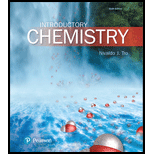
Concept explainers
Climate scientists have become increasingly concerned that rising levels of carbon dioxide in the atmosphere (produced by the burning fuels) will affect the global climate in harmful ways such as increased temperatures, rising sea levels, and coastal flooding. The graph at right shows the concentration of carbon dioxide in the atmosphere from the mid-1800s to the present time. Study the graph and answer the questions that follow.
Atmospheric Carbon Dioxide

(a) What were the carbon dioxide concentrations in 1950 and 2000? How much did the carbon dioxide concentration increase during these 50 years?
(b) What was the average yearly increase between 1950 and 2000?
(c) Beginning from the carbon dioxide concentration in 2010 (390ppm), and assuming the average yearly increase you calculated in part b, what will the carbon dioxide concentration be in 2050?
Want to see the full answer?
Check out a sample textbook solution
Chapter 5 Solutions
Introductory Chemistry (6th Edition)
- Consider the chemical reaction 2 S + 3 O2 → 2 SO3. If the reaction is run by adding S indefinitely to a fixed amount of O2, which of these graphs best represents the formation of SO3? Explain your choice.arrow_forwardIf you had a mole of U.S. dollar bills and equally distributed the money to all of the people of the world, how rich would every person be? Assume a world population of 7 billion.arrow_forward3.55 An average person inhales roughly 2.5 g of O2 in a minute. How many molecules of oxygen are inhaled in (a) 1 minute, (b) 1 hour, (c) 1 day by an average person?arrow_forward
- The chemical formula of trinitrotoluene (TNT) is C7H5N3O6. What is the molecular mass of TNT? Express your answer to at least five significant figures. ? g/molarrow_forwardA 15-g sample of lithium is reacted with 15 g of fluorine to form lithium fluoride: 2Li + F2 → 2LiF. After the reaction is complete, what will be present?arrow_forwardChemists use various ways to express concentration quantitatively. What are they?arrow_forward
- Please write the chemical reaction exactly as described below. The products are one mole of liquid water, one mole of carbon dioxide gas, and two moles of aqueous potassium chloride. The reactants are one mole of solid potassium carbonate and two moles of aqueous hydrochloric acid. Use the editor to format your answerarrow_forwardwww-awn.aleks.com Search for water bottles - Sam's Club ALEKS - Brittney Ortega - Learn My Questions | bartleby CHEMICAL REACTIONS Brittney Solving for a reactant using a chemical equation Ammonia (NH3) chemically reacts with oxygen gas (02) to produce nitric oxide (NO) and water (H,0). What mass of water is produced by the reaction of 2.28 g of oxygen gas? Round your answer to 3 significant digits. alo x10 Ar ? Explanation Check © 2021 McGraw-Hill Education. All Rights Reserved. Terms of Use | Privacy | Accessibilityarrow_forwardAn air conditioner compressor contains pure CClF3, also known as the refrigerant R-13. CClF3 has a density of 1.53x10^-3 g/L when unpressurized. If the volume of the unpressurized compressor is 0.500 L, how many molecules of CClF3 are in the compressor? a) 4.41x10^18 b) 8.82x10^18 c) 4.60x10^20 d) 1.04x10^2arrow_forward
 Chemistry: An Atoms First ApproachChemistryISBN:9781305079243Author:Steven S. Zumdahl, Susan A. ZumdahlPublisher:Cengage Learning
Chemistry: An Atoms First ApproachChemistryISBN:9781305079243Author:Steven S. Zumdahl, Susan A. ZumdahlPublisher:Cengage Learning Chemistry: The Molecular ScienceChemistryISBN:9781285199047Author:John W. Moore, Conrad L. StanitskiPublisher:Cengage Learning
Chemistry: The Molecular ScienceChemistryISBN:9781285199047Author:John W. Moore, Conrad L. StanitskiPublisher:Cengage Learning Introductory Chemistry: A FoundationChemistryISBN:9781337399425Author:Steven S. Zumdahl, Donald J. DeCostePublisher:Cengage Learning
Introductory Chemistry: A FoundationChemistryISBN:9781337399425Author:Steven S. Zumdahl, Donald J. DeCostePublisher:Cengage Learning ChemistryChemistryISBN:9781305957404Author:Steven S. Zumdahl, Susan A. Zumdahl, Donald J. DeCostePublisher:Cengage Learning
ChemistryChemistryISBN:9781305957404Author:Steven S. Zumdahl, Susan A. Zumdahl, Donald J. DeCostePublisher:Cengage Learning
 World of Chemistry, 3rd editionChemistryISBN:9781133109655Author:Steven S. Zumdahl, Susan L. Zumdahl, Donald J. DeCostePublisher:Brooks / Cole / Cengage Learning
World of Chemistry, 3rd editionChemistryISBN:9781133109655Author:Steven S. Zumdahl, Susan L. Zumdahl, Donald J. DeCostePublisher:Brooks / Cole / Cengage Learning





